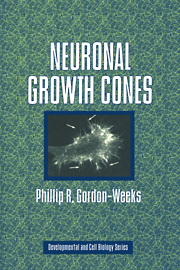4 - Intracellular Signalling in Growth Cones
Published online by Cambridge University Press: 29 August 2009
Summary
Introduction
Axonal guidance cues can influence growth cone behaviour by binding to specific, cell surface receptors on growth cones. Activation of such receptors produces intracellular signalling events, which leads to changes in growth cone behaviour. The principal target of intracellular signalling pathways in growth cones is the cytoskeleton – the ‘final common path of action’ of guidance cues because it underlies growth cone motility and neurite extension – although other growth cone functions, such as plasma membrane growth, may also be targeted. Our understanding of the intracellular signalling pathways in growth cones is still fairly rudimentary. There are three main reasons for this. Firstly, although several families of guidance molecules have been identified and characterised, the growth cone receptors for these molecules, and thus their intracellular signalling mechanisms, are only now being discovered (see Chapter 3). Secondly, most experiments on signalling mechanisms have been done in vitro and focus on assaying neurite outgrowth rather than the pathfinding behaviour of growth cones, such as growth cone turning, for instance, in ‘choice’ assays (see Chapter 3), which more closely resemble growth cone pathfinding in vivo. Thirdly, there is considerable reliance on the use of pharmacological reagents to inhibit or disrupt signalling pathways, an approach which is often compromised by lack of specificity or the unavailability of more than one reagent with a different mechanism of action.
Several methodological advances have had a significant impact on our understanding of the signalling events within neurites and growth cones.
- Type
- Chapter
- Information
- Neuronal Growth Cones , pp. 137 - 159Publisher: Cambridge University PressPrint publication year: 2000



